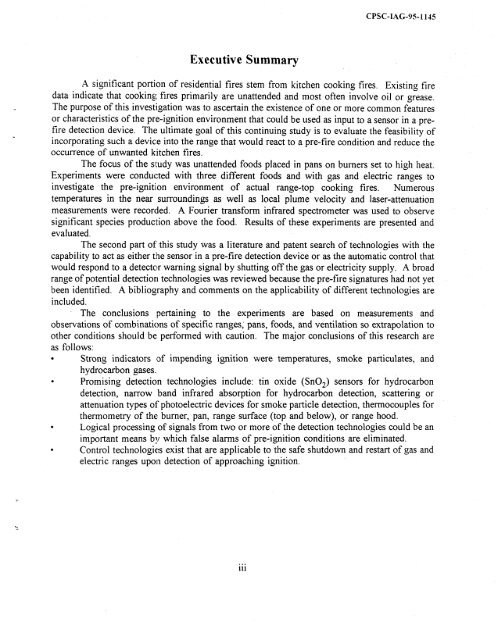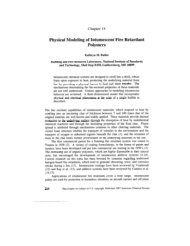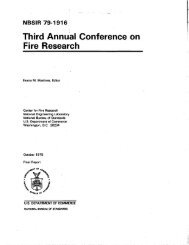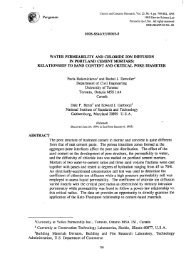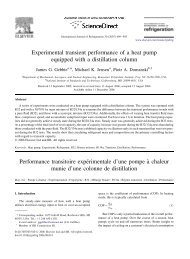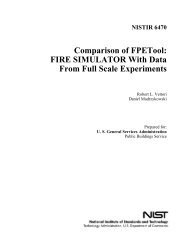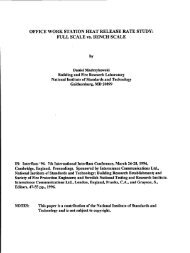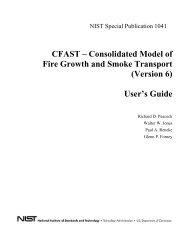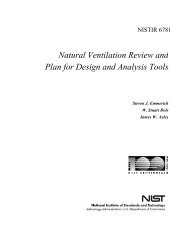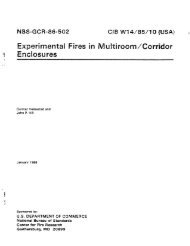Study of Technology for Detecting Pre-Ignition Conditions of ... - NIST
Study of Technology for Detecting Pre-Ignition Conditions of ... - NIST
Study of Technology for Detecting Pre-Ignition Conditions of ... - NIST
Create successful ePaper yourself
Turn your PDF publications into a flip-book with our unique Google optimized e-Paper software.
Executive Summary<br />
CPSC-LAG-95-1145<br />
A significant portion <strong>of</strong> residential fires stem from kitchen cooking fires. Existing fire<br />
data indicate that cooking fires primarily are unattended and most <strong>of</strong>ten involve oil or grease.<br />
The purpose <strong>of</strong> this investigation was to ascertain the existence <strong>of</strong> one or more common features<br />
or characteristics <strong>of</strong> the pre-ignition environment that could be used as input to a sensor in a prefire<br />
detection device, The ultimate goal <strong>of</strong> this continuing study is to evaluate the feasibility <strong>of</strong><br />
incorporating such a device into the range that would react to a pre-fire condition and reduce the<br />
occurrence <strong>of</strong> unwanted kitchen fires.<br />
The focus <strong>of</strong> the study was unattended foods placed in pans on burners set to high heat.<br />
Experiments were conducted with three different foods and with gas and electric ranges to<br />
investigate the pre-igniti,on environment <strong>of</strong> actual range-top cooking fires. Numerous<br />
temperatures in the near surroundings as well as local plume velocity and laser-attenuation<br />
measurements were recorded. A Fourier trans<strong>for</strong>m infrared spectrometer was used to observe<br />
significant species production above the food. Results <strong>of</strong> these experiments are presented and<br />
evaluated.<br />
The second part <strong>of</strong> this study was a literature and patent search <strong>of</strong> technologies with the<br />
capability to act as either the sensor in a pre-fire detection device or as the automatic control that<br />
would respond to a detectcr warning signal by shutting <strong>of</strong>f the gas or electricity supply. A broad<br />
range <strong>of</strong> potential detection technologies was reviewed because the pre-fire signatures had not yet<br />
been identified. A bibliography and comments on the applicability <strong>of</strong> different technologies are<br />
included.<br />
The conclusions pertaining to the experiments are based on measurements and<br />
observations <strong>of</strong> combinations <strong>of</strong> specific ranges; pans, foods, and ventilation so extrapolation to<br />
other conditions should be per<strong>for</strong>med with caution. The major conclusions <strong>of</strong> this research are<br />
as follows:<br />
● Strong indicators <strong>of</strong> impending ignition were temperatures, smoke particulate, and<br />
hydrocarbon gases.<br />
● Promising detection technologies include: tin oxide (Sn02) sensors <strong>for</strong> hydrocarbon<br />
detection, narrow band infrared absorption <strong>for</strong> hydrocarbon detection, scattering or<br />
attenuation types <strong>of</strong> photoelectric devices <strong>for</strong> smoke particle detection, thermocouples <strong>for</strong><br />
thermometry <strong>of</strong> the burner, pan, range surface (top and below), or range hood.<br />
● Logical processing <strong>of</strong> signals from two or more <strong>of</strong> the detection technologies could be an<br />
important means by which false alarms <strong>of</strong> pre-ignition conditions are eliminated.<br />
● Control technologies exist that are applicable to the safe shutdown and restart <strong>of</strong> gas and<br />
electric ranges upon detection <strong>of</strong> approaching ignition.<br />
...<br />
111


